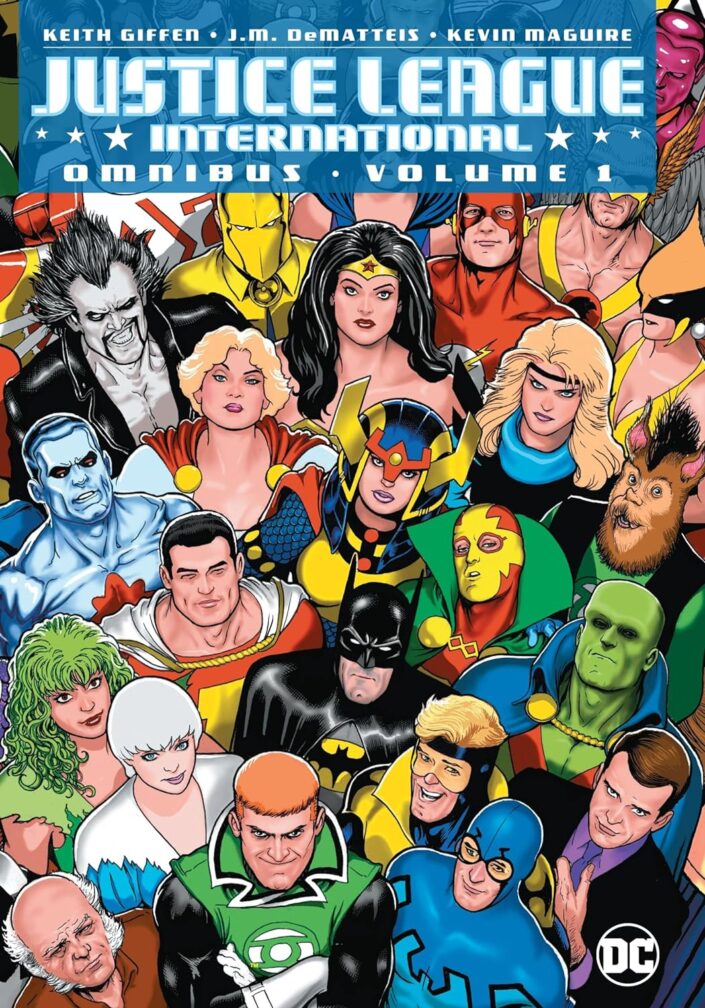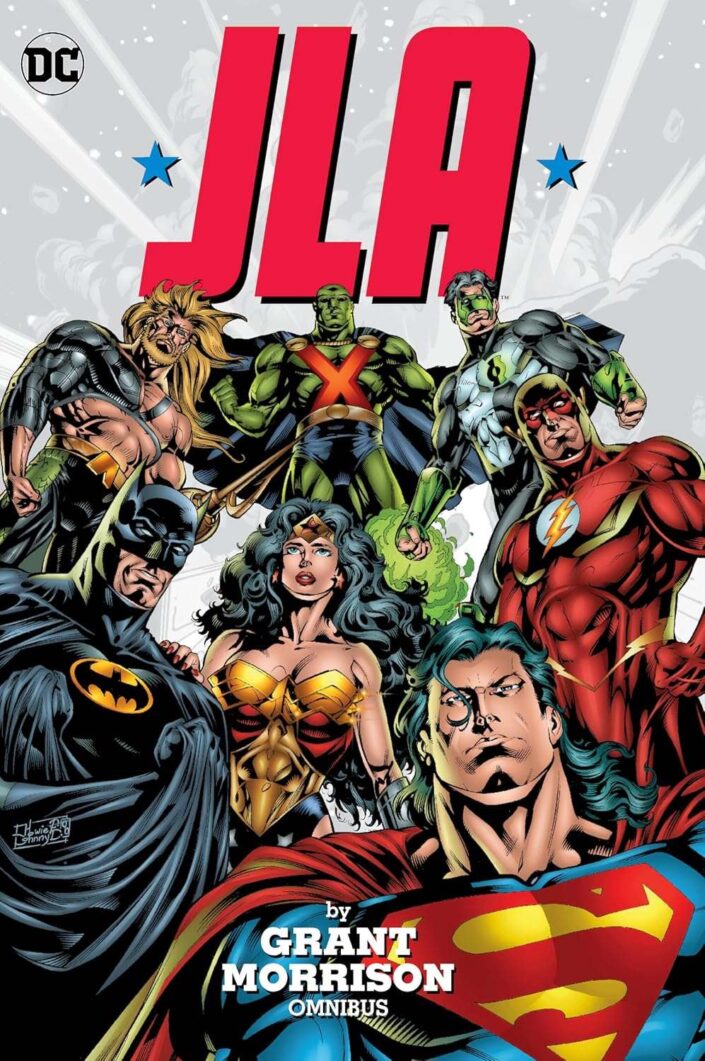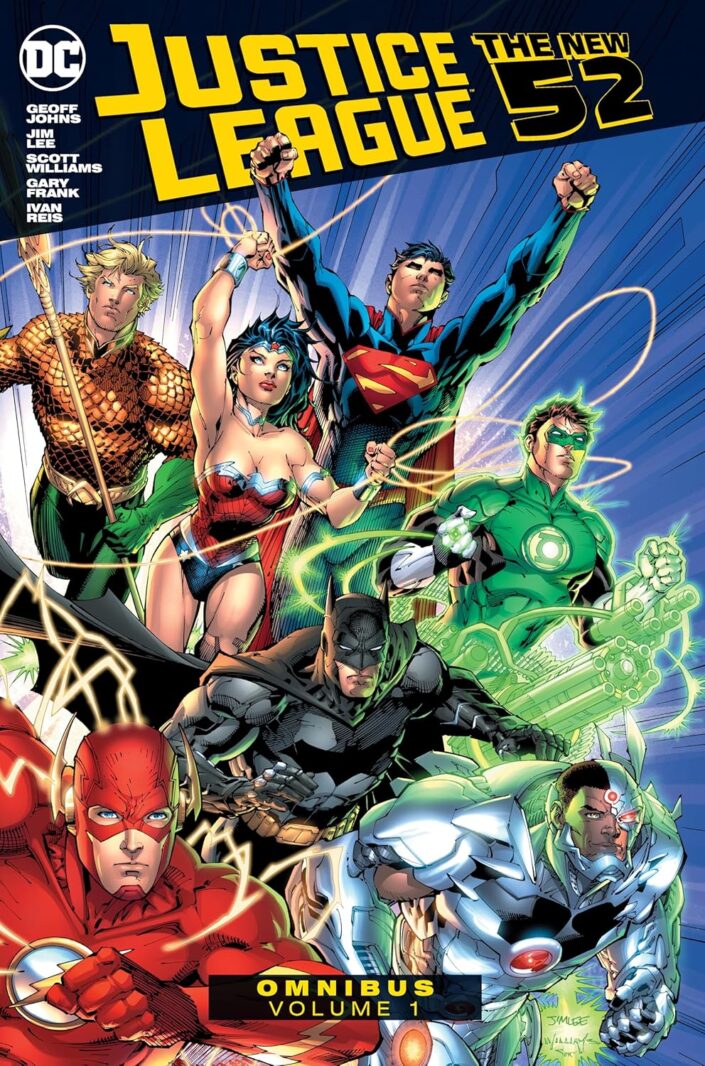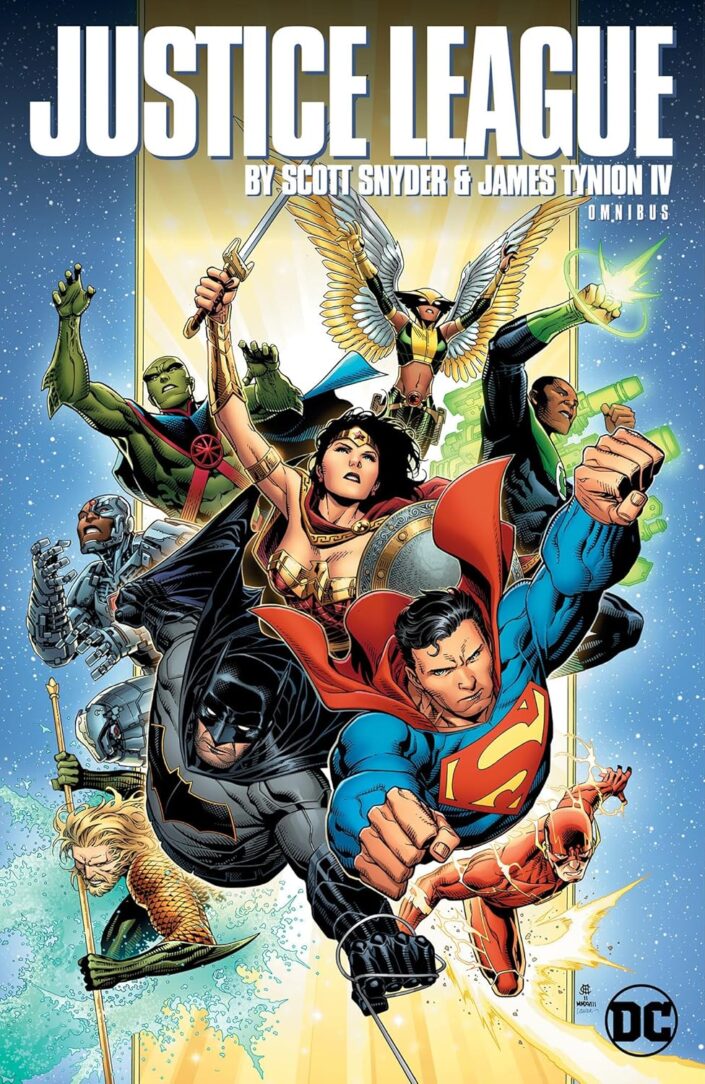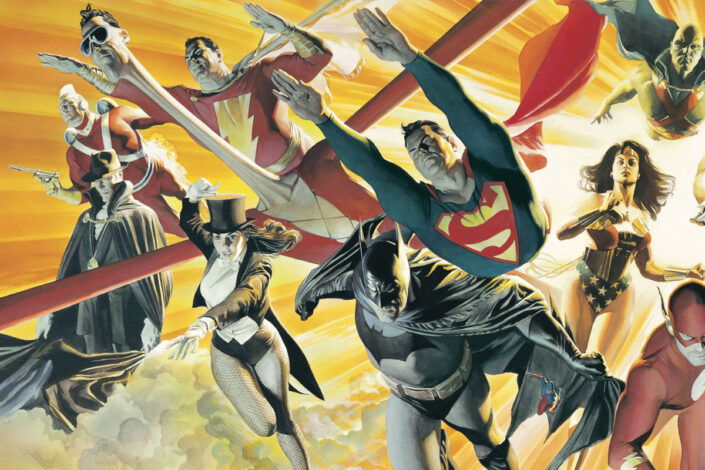
Almost nine years after the end of the original JSA comic book run, DC Comics introduced another team of Super Heroes in The Brave and the Bold #28 (dated March 1960) by writer Gardner Fox and artist Mike Sekowsky. It was viewed as a modernization of the Justice Society but with a new name chosen by editor Julius Schwartz who thought that a “‘Society’ meant something you found on Park Avenue”. He went with “League” instead–because of the popularity of the baseball leagues.
The first Justice League team was composed of Aquaman, Flash, Green Lantern, Martian Manhunter, and Wonder Woman, but also of Superman and Batman, even if they were mostly absent from the League’s early adventures (it was thought that they would quickly become overused if they appeared in too many titles). Soon, the team would welcome Green Arrow, the Atom, and Hawkman.
The Justice League comics became a hit. As the years passed, the roaster of superheroes changed a little, the DC Universe became more connected and events were organized like the famous annual crossovers with the Justice Society.
Justice League Reading Order:
As usual, there are different eras in the DC Universe, and the Justice League, like the team members, evolved in consequences. Some periods of the Justice League comics may not be easy to find.
The Justice League Comics Eras: The Menu
With every new era comes a new relaunch of the team. You can start wherever you want. We recommend The JLA Era by Grant Morrison because those are excellent comics. The Justice League International offers a more comedic take on the team, even if it becomes more serious by the end.
- Justice League of America: The Silver Age/Bronze Age
- Justice League International: The Post-Crisis Era
- The JLA Era (Grant Morrison and Beyond) recommended entry point
- Justice League of America (Volume 2): The Pre-New 52 Era
- Justice League: The New 52 Era
- Justice League: The Rebirth Era
- Justice League: The Infinite Frontier Era
- Justice League: The All In Era
Reading The Justice League of America Comics in Order: The Silver Age/Bronze Age (Pre-Crisis)
This is when everything started, in 1960. After three issues of The Brave and the Bold comics, DC Comics launched the first Justice League of America comic book series (#1 is dated November 1960). The original team was founded by Superman, Batman, Aquaman, Flash, Green Lantern, Martian Manhunter, and Wonder Woman. Green Arrow joined in Justice League of America #4, Atom in #14, Hawkman in #31, Metamorpho in #42, Black Canary in #74, and more followed.
This first volume of the Justice League of America comics ended with #261 in April 1987.
The Justice League of America Comics during The Silver Age
Those stories (Silver and Bronze Age) were previously republished in two other collections: Justice League of America Archives (from B&B #28 to JLA #93) and Showcase Presents Justice League of America (from B&B #28 to JLA #132).
The Silver Age Justice League Omnibus Collection
- Justice League of America: The Silver Age Omnibus Volume 1
Collects The Brave and the Bold #28-30, Justice League of America #1-30.- Previously published as Justice League of America Omnibus Volume 1.
- Justice League of America: The Silver Age Omnibus Volume 2
Collects Justice League of America #31-76, Mystery in Space #75.
The Silver Age Justice League Paperback Collection
- Justice League of America: The Silver Age Vol. 1
Collects The Brave and the Bold #28-30, Justice League of America #1-8, and Mystery in Space #75. - Justice League of America: The Silver Age Vol. 2
Collects Justice League of America #9-19. - Justice League of America: The Silver Age Vol. 3
Collects Justice League of America #20-30. - Justice League of America: The Silver Age Vol. 4
Collects Justice League of America #31-41.
The DC Finest Collection
This new DC Finest collection reprints tales of the Justice League of America from the end of the Silver Age:
- DC Finest: Justice League of America – The Bridge Between Earths new
Collects Justice League of America #45-72.
The Justice League of America Comics during The Bronze Age
The Bronze Age Justice League of America Omnibus Collection
- Justice League of America: The Bronze Age Omnibus Vol. 1
Collects Justice League of America #77–113 - Justice League of America: The Bronze Age Omnibus Vol. 2
Collects Justice League of America #114–146, DC Super-Stars #10. - Justice League of America: The Bronze Age Omnibus Vol. 3
Collects Justice League of America #147-182, Super-Team Family #11-14, DC Special #27, DC Special Series #6, Secret Society of Super-Villains #15, DC Comics Presents #17, and pages from Amazing World of DC comics #14. - More to come…
- Justice League of America: The Detroit Era Omnibus
Collects Justice League of America #233–261, Justice League of America Annual #2–3, JLA Classified #22–25, JSA Classified #14–16, DC Retroactive: JLA – The 80’s #1 and Infinity Inc. #19.
Notes on the Detroit Era of the Justice League:
In Justice League of America Annual #2 (dated 1984), writer Gerry Conway introduced a new line-up of the Justice League team to stop the slow fall of sales. DC Comics’ idea was to try to emulate the success of the New Teen Titans comic book (in which the members were exclusive to the title). Consequently, all of the JLA members who got their own comic book series were out (meaning most of them). Now, Aquaman, Zatanna, Elongated Man, J’onn J’onzz, Steel, Vixen, Vibe, and Gypsy were the members of the Justice League team. Also, they stopped using the Earth-orbiting satellite and instead used a warehouse/bunker in Detroit as their base of operation. The idea was to do something new by rooting the JLA in a neighborhood.
And then came the Crisis!
The Crisis On Multiple Earths
The original “Crisis” took place in the first Justice League of America #21. The story introduced the idea of two different realities in order to explain how the heroes of the Justice League teamed up with their predecessors the Justice Society of America. This led to multiple crossovers between Earth-One and Earth-Two.
These next comic books are collecting the famous Multiple Earths team-ups from the Silver/Bronze Age era:
- Crisis on Multiple Earths Volume 1
Collects Justice League of America #21–22, 29–30, 37–38, 46–47 - Crisis on Multiple Earths Volume 2
Collects Justice League of America #55–56, 64–65, 73–74, 82–83 - Crisis on Multiple Earths Volume 3
Collects Justice League of America #91–92, 100–102, 107–108, 113 - Crisis on Multiple Earths Volume 4
Collects Justice League of America #123–124, 135–137, 147–148 - Crisis on Multiple Earths Volume 5
Collects Justice League of America #159–160, 171–172, 183–185 - Crisis on Multiple Earths Volume 6
Collects Justice League of America #195–197, 207–209, All-Star Squadron #14–15
Crisis on Infinite Earths is the first universe-redefining crossover comic book event ever. The goal was to simplify and unify the DC Universe. As a consequence, the full line-up was relaunched after the crisis, including the Justice League comics. To read this event, you can stick to the main maxiseries (see below) or explore the whole event.
- Crisis on Infinite Earths (the 2001 TPB edition)
Collects Crisis on Infinite Earths #1-12.
Reading The Justice League International Comics in Order: The Post-Crisis Era
Written by Keith Giffen and J. M. DeMatteis, with art by Kevin Maguire, the Justice League International (JLI) was created in 1987. It was not a team of A-listers. In fact, it was considered as a joke and, with what they got, Giffen and DeMatteis created a sitcom-like version of the Justice League team. One that is still quite unique to this day.
For now, this run is not fully collected yet. Here is the strict minimum, for more (other collections, issue by issue order), visit our article about the Justice League International Reading Order that goes into it issue by issue.
- Justice League International Omnibus Vol. 1
Collects Justice League #1-6, Justice League International #7-25, Justice League America #26-30, Justice League Annual #1, Justice League International Annual #2-3, Justice League Europe #1-6, and Suicide Squad #13. - Justice League International Omnibus Vol. 2
Collects Justice League America #31-50, Justice League Europe #7-25, Justice League America Annual #4, Justice League Europe Annual #1, Justice League Quarterly #1, and Justice League International Special #1. - Justice League International Omnibus Vol. 3
Collects Justice League America #51-60, Secret Origins #33-35, Justice League America Annual #5, Green Lantern #18, Justice League Quarterly #2-5, JLA 80-Page Giant #1, Formerly Known As The Justice League #1-6, JLA: Classified #4-9, Justice League Europe #26-36, DC Retroactive: JLA–The ’90s #1, Justice League Europe Annual #2, and Justice League International Special #2.
Once Keith Giffen and J. M. DeMatteis left the Justice League comics, the new writer was Dan Jurgens. He worked on Justice League America #61–77, Justice League Spectacular #1, and Justice League International (vol. 3) #1–12. Then, Dan Vado took over, writing Justice League America #78–91 & Annual #8, before being replaced by Gerard Jones who took the title to its conclusion.
Some of those Justice League comics are collected here:
- Superman & Justice League America Vol. 1
Collects Justice League America #60–68 and Justice League Spectacular #1. - Superman & Justice League America Vol. 2
Collects Justice League America #69–77, Annual #7. - Wonder Woman and Justice League America Vol. 1
Collects Justice League America #78–85, Justice League America Annual #7. - Justice League Task Force Vol. 1: Purification Plague
Collects Justice League Task Force #1-12. - Wonder Woman and Justice League America Vol. 2
Collects Justice League America #86–91, Justice League International (vol. 2) #65–66, and Justice League Task Force #13–14.- Justice League America #92, Justice League International #68, and Justice League Task Force #16 are part of the Zero Hour event (see reading order).
The Justice League comic book series ended with issue #113. Gerard Jones’ issues have not been collected yet.
In 2003 and 2005, Keith Giffen, J. M. DeMatteis, Kevin Maguire, and Joe Rubinstein got back together to write two Justice League comics miniseries working as a sequel to their Justice League International run: Maxwell Lord decides to open a super-team-for-hire in a suburban strip mall, but first he’ll need to recruit the team itself! Naturally, he turns to his old pals from the Justice League, but are Blue Beetle, Booster Gold, Fire, Elongated Man, Captain Atom, and Mary Marvel up for the idea?
- Formerly Known as the Justice League
Collects Formerly Known as the Justice League #1-6. - I Can’t Believe It’s Not the Justice League
Collects JLA: Classified #4–9.
The JLA Era
Once again, the time had come to relaunch the Justice League comics in an attempt to stop the falling sales. DC Comics tried to revamp the League with the help of Mark Waid and Fabian Nicieza with the miniseries Justice League: A Midsummer’s Nightmare. But it was in 1997 when Grant Morrison reformed the Justice League with artist Howard Porter in the new JLA comics that the team found success again.
Once again, here is the strict minimum, for more (other collections), go to our dedicated article about reading Grant Morrison’s JLA comics in order.
- Justice League: A Midsummer’s Nightmare
Collects Justice League: A Midsummer’s Nightmare #1-3. - JLA by Grant Morrison Omnibus
Collects JLA #1-17, #22-26, #28-31, #34, #36-#41, JLA One Million, and JLA: Earth 2.- For more information about the DC One Million event, go to our reading order.
- JLA: Year One
Collects JLA: Year One #1-12. A new take on the origins of the Justice League of America by Mark Waid, Brian Augustyn, and Barry Kitson. Can be read after Morrison’s first storyline.
Once Grant Morrison left the JLA comics, Mark Waid took over and wrote one of the most famous JLA storylines, The Tower of Babel. With Joe Kelly, Waid stayed on this Justice League comics until #90, then a series of rotating writers took charge until the cancellation with JLA #126.
- JLA: The Tower of Babel
Collects JLA #18-21, #32-33, and #43-46, and two stories from JLA Secret Files #3. - JLA: Divided We Fall
Collects JLA #47–54. - JLA: Terror Incognita
Collects JLA #55–60. - JLA: Golden Perfect
Collects JLA #61–65. - JLA: The Obsidian Age Book 1
Collects JLA #66–71. - JLA: The Obsidian Age Book 2
Collects JLA #72–76. - JLA/JSA: Virtue and Vice
An Original Graphic Novel - JLA: Rules of Engagement
Collects JLA #77–82. - JLA: Trial by Fire
Collects JLA #84–89. - JLA: The Tenth Circle
Collects JLA #94–99.
Introduced at the end of JLA #100, the Justice League Elite team is a not-exactly-sanctioned, don’t-ask-don’t-tell, covert operations unit– newly formed to hunt and eliminate extra-normal threats to the earth before they go public.
- Justice League Elite Vol. 1
Collects Action Comics #775, JLA #100, JLA Secret Files 2004, and Justice League Elite #1–4. - JLA: Pain of the Gods
Collects JLA #101–106. - Justice League Elite Vol. 2
Collects Justice League Elite #5-12 - JLA: Syndicate Rules
Collects JLA #107–114, a story from JLA Secret Files and Origins 2004.
Alert Event! There’s an Identity Crisis in the DCU. After the spouse of a member of the Justice League of America team is brutally murdered, the entire superhero community searches for the killer, fearing their loved ones may be the next target. But before the mystery is fully solved, long-buried secrets of the heroes rise to the surface, threatening to tear apart and divide the heroes before they can bring the mysterious killer to justice. As usual, you can stick to reading the main miniseries or read the tie-ins with the help of our Identity Crisis Reading Order.
- Identity Crisis
Collects Identity Crisis #1-7. - JLA: Crisis of Conscience
Collects JLA #115–119. (lead up to Infinite Crisis) - JLA: World Without a Justice League
Collects JLA #120–125. (part of Infinite Crisis, see below)
Alert Event! And now, here comes the Infinite Crisis comics event. OMAC robots are rampaging, magic is dying, villains are uniting, and a war is raging in space. And in the middle of it all, a critical moment has divided Earth’s three greatest heroes: Superman, Batman, and Wonder Woman. It’s the DCU’s darkest day, and long-lost heroes from the past have returned to make things right in the universe… at any cost. Heroes will live, heroes will die, and the DCU will never be the same again! That’s a big event, check out our dedicated article to read the Infinite Crisis comics in order.
- Infinite Crisis Omnibus
Collects Action Comics #826, #829, Adventures of Superman #639, #642, Countdown to Infinite Crisis, Day of Vengeance #1-6, Day of Vengeance Infinite Crisis Special, JLA #115-119, Infinite Crisis #1-6, Infinite Crisis Secret Files 2006, The OMAC Project #1-6, The OMAC Project Infinite Crisis Special, Rann-Thanagar War #1-6, The Rann-Thanagar Infinite Crisis Special, Superman #216, #219, Villains United #1-6, Villains United Infinite Crisis Special and Wonder Woman #219.
Reading The Justice League of America Comics in Order: Volume 2 – The Pre-New 52 Era
Following the Infinite Crisis crossover event, DC Comics decided to relaunch Justice League of America comics with a new number 1. This time, the JL Comic book is written by Brad Meltzer with artist Ed Benes.
- Justice League of America: The Tornado’s Path
Collects Justice League of America (vol. 2) #1–7. - Justice League of America: The Lightning Saga
Collects Justice League of America (vol. 2) #0, #8–12; Justice Society of America (vol. 3) #5–6. - Justice League of America: The Injustice League
Collects Justice League of America (vol. 2) #13–16; JLA Wedding Special #1. - Justice League of America: Sanctuary
Collects Justice League of America (vol. 2) #17–21. - Justice League of America: The Second Coming
Collects Justice League of America (vol. 2) #22–26. - Justice League of America: When Worlds Collide
Collects Justice League of America (vol. 2) #27–28, #30–34.- #29 is part of the “Faces of Evil” crossover (not collected).
- Final Crisis happened between #31 and 32, for more information, take a look at our Final Crisis Reading Order.
- #35-37 are not collected yet.
- JLApe: The Complete Collection
Collects Legends of the DC Universe #19, JLA Annual #3, Batman Annual #23, Aquaman Annual #5, Wonder Woman Annual #8, The Flash Annual #12, Superman Annual #11, Green Lantern Annual #8, and Martian Manhunter Annual #2. - Justice League: Cry for Justice
Collects Justice League: Cry for Justice #1-7. - Justice League of America: Team History
Collects Justice League of America (vol. 2) #38–43.- #39-40 are part of the Blackest Night event, see reading order here.
- Justice League of America: The Dark Things
Collects Justice League of America (vol. 2) #44–48; Justice Society of America (vol. 3) #41–42.- This book collects the issues that are part of the “Brightest Day” storyline. To know how to read them, as well as the JL: Generation Lost maxiseries (a “sequel” to JLI written by Keith Giffen and Judd Winick), go to our Brightest Day Reading Order.
- Justice League: Generation Lost Vol. 1
Collects Justice League: Generation Lost #1-12.
- Justice League of America: Omega
Collects Justice League of America (vol. 2) #49–53. - Justice League of America: The Rise of Eclipso
Collects Justice League of America (vol. 2) #54–60, Justice Society of America (vol. 3) #43.- Justice League: Generation Lost Vol. 2
Collects Justice League: Generation Lost #13-24.
- Justice League: Generation Lost Vol. 2
Reading The Justice League Comics in Order: The New 52 Era
In 2011, when DC Comics relaunched its line of superhero comic books for a partial reboot and with a new continuity. This New 52 era began with a new origin story for the Justice League team, featuring initial members Superman, Batman, Green Lantern, Flash, Wonder Woman, Aquaman, and Cyborg. The heroes must come together when loner vigilante Batman stumbled upon a dark evil that threatens to destroy the earth as we know it. To save the world, they must put aside their differences…
Once again, here is the strict minimum, for a lot more–other collections, events, crossovers, and series (like the 3rd volume of JLI)–, go to our Justice League New 52 Reading Order. You can also check out our guide to reading the Justice League Dark comics in order.
- Justice League: The New 52 Omnibus Vol. 1
Collects Justice League #0-22; Aquaman #14-16; Justice League Dark #22-23; DC Comics – The New 52 FCBD Special Edition #1; Justice League of America #6-7; Trinity of Sin: The Phantom Stranger #11; Constantine #5; Trinity of Sin: Pandora #1-3.- Justice League Dark: The New 52 Omnibus
Collects Justice League Dark: The New 52 Omnibus collecting I, Vampire #7-8; Justice League Dark #0-40; Justice League#22-23; Justice League Dark Annual #1-2; Justice League of America#6-7; Trinity of Sin: The Phantom Stranger #14-17; Constantine #9-12; Trinity of Sin: Pandora #6-9; Justice League Dark: Futures End #1.
- Justice League Dark: The New 52 Omnibus
- Justice League: The New 52 Omnibus Vol. 2
Collects Justice League #24-52, Forever Evil #1-7, DC Universe: Rebirth #1, DC Sneak Peek: Justice League #1, Justice League feat. Secret Society #234, Justice League of America feat. Black Adam #74, Justice League: Darkseid War Special #1, Justice League: Darkseid War: Batman #1, Justice League: Darkseid War: The Flash #1, Justice League: Darkseid War: Green Lantern #1, Justice League: Darkseid War: Lex Luthor #1, Justice League: Darkseid War: Shazam #1, and Justice League: Darkseid War: Superman #1.
Reading The Justice League Comics: The Rebirth Era
Once again, in 2016, DC Comics relaunched its comic book line. It’s the Rebirth era and with it came a new Justice League. Not a new team, but a new volume of the Justice League comics coming from Bryan Hitch and Tony S. Daniel.
Here is the strict minimum you need to follow the story, but there’s no omnibus to cut short that part. That said, there’s still a lot more–other collections, events, crossovers, and series–, so check out our Justice League Rebirth Reading Order for details.
- Justice League: The Rebirth Deluxe Edition – Book 1
Collects Justice League: Rebirth #1, Justice League (vol. 3) #1–11 - Justice League vs. Suicide Squad
Collects Justice League vs. Suicide Squad #1-6, Justice League #12-13, and Suicide Squad #8-10
This event led Batman to create a new Justice League of America team–this 5th volume of the Justice League comics is coming from Steve Orlando and Ivan Reis.
- Justice League of America: The Road to Rebirth
Collects Justice League of America: Rebirth #1, Justice League of America: Killer Frost #1, Justice League of America: The Ray #1, Justice League of America: The Atom #1, Justice League of America: Vixen #1 - Justice League of America Vol. 1: The Extremists
Collects Justice League of America (vol. 5) #1–6 - Justice League of America Vol. 2: Curse of the Kingbutcher
Collects Justice League of America (vol. 5) #7–11 - Justice League of America Vol. 3: Panic in the Microverse
Collects Justice League of America (vol. 5) #12–17 - Justice League: The Rebirth Deluxe Edition – Book 2
Collects Justice League (vol. 3) #12–25 - Justice League: The Rebirth Deluxe Edition – Book 3
Collects Justice League (vol. 3) #26–33
Dark Nights: Metal! This Batman Event written by Scott Snyder and Greg Capullo introduced the Dark Multiverse and this triggers events that will change the DC Universe. Members of the Justice League play a role in this event (except for some ties-in in The Resistance part) and this story will shape what’s to come for the team. It’s a big and complicated event, but we have a complete guide to reading the Dark Nights: Metal comics in order (with an issue-by-issue order).
- Dark Nights: Metal
Collects Dark Nights: Metal #1-6, Dark Knights Rising: The Wild Hunt #1, and Batman Lost #1.- Justice League #32-33 are part of the event.
- Justice League by Christopher Priest Deluxe Edition
Collects Justice League (vol. 3) #34–43
The Justice League Comics by Snyder and Tynon
At that point, DC Comics abandoned the Rebirth banner and just went with DC Universe instead. That’s when Scott Snyder and James Tynion IV became the creative force behind the Justice League line (with art from Jim Cheung, Jorge Jimenez, Francis Manapul, and Bruno Redondo), building their epic tale to lead us to Dark Nights: Death Metal.
This era has now entered the Omnibus collection:
- Justice League by Scott Snyder and James Tynion IV Omnibus new
Collects Aquaman #41-42; Teen Titans #28; Justice League: No Justice #1-4; Justice League #1-25; Justice League/Aquaman: Drowned Earth Special #1; Aquaman/Justice League: Drowned Earth Special #1; The Batman Who Laughs #1-7; Justice League Annual #1.
Here is the trade paperback collection in order:
- Justice League: No Justice
Collects Justice League: No Justice #1–4, plus a story from DC Nation #0
Spinning out of Justice League: No Justice Comics, DC launched three Justice League comic book series. The main Justice League comics, the Justice League Dark comics (available in Omnibus!), and Justice League Odyssey comics. As each one follows a distinctive team dealing with different story elements, you can read whichever you want. And despite the fact the stories take place concurrently, you don’t have to read them together if you don’t want to.
- Justice League by Scott Snyder Deluxe Edition Book One
Collects Justice League (vol. 4) #1–13, Justice League/Aquaman: Drowned Earth #1, Aquaman/Justice League: Drowned Earth #1- Justice League Dark Vol. 1: The Last Age of Magic
Collects Justice League Dark vol. 2, #1-3 and #5-7 - Wonder Woman & The Justice League Dark: The Witching Hour
Collects Justice League Dark and Wonder Woman #1, and Wonder Woman and Justice League Dark #1, Wonder Woman #56-57, Justice League Dark vol. 2, #4 - Justice League Odyssey Vol. 1: The Ghost Sector
Collects Justice League Odyssey #1-5
- Justice League Dark Vol. 1: The Last Age of Magic
- Justice League by Scott Snyder Deluxe Edition Book Two
Collects Justice League (vol. 4) #14–25, Annual #1- Justice League Dark Vol. 2: Lords of Order
Collects Justice League Dark vol. 2, #8-13 and Justice League Dark Annual #1 - Justice League Dark Vol. 3: The Witching War
Collects Justice League Dark vol. 2, #14-19 - Justice League Odyssey Vol. 2: Death of the Dark
Collects Justice League Odyssey #6-12.
- Justice League Dark Vol. 2: Lords of Order
- Justice League by Scott Snyder Deluxe Edition Book Three
Collects Justice League (vol. 4) #26–39- Justice League Odyssey Vol. 3: The Final Frontier
Collects Justice League Odyssey #13-18. - Justice League Dark Vol. 4: A Costly Trick of Magic
Collects Justice League Dark vol. 2, #20-28
- Justice League Odyssey Vol. 3: The Final Frontier
- Year of the Villain: Hell Arisen
Collects: Year Of The Villain: Hell Arisen #1 To #5.- Justice League Vol. 6: Vengeance Is Thine
Collects: Justice League #40-47 - Justice League Vol. 7: Galaxy of Terrors
Collects: Justice League #48-52 - Justice League Odyssey Vol. 4: Final Frontier
Collects Justice League Odyssey #19-25.
- Justice League Vol. 6: Vengeance Is Thine
Dark Nights: Death Metal! The follow-up to the Dark Nights: Metal crossover event sees the Justice League at the mercy of the Batman Who Laughs. Humanity struggles to survive in a hellish landscape twisted beyond recognition, while Batman, Wonder Woman, and Superman have all been separated and must fight to survive. This event leads us to the next event Future State and a new era, Infinite Frontier. Like Dark Nights: Metal, the Death Metal crossover has a lot of tie-ins. Still, you can stick to the main miniseries or check out our Dark Nights Death Metal reading order for an issue-by-issue guide.
- Dark Nights: Death Metal Deluxe Edition
Collects Dark Nights: Death Metal #1-7. - Justice League Vol.8: Death Metal
Collects Justice League #53-57.
Justice League: Endless Winter! Though a mostly self-contained story, this little comic book event is a sort of filler between two eras, taking place after Dark Nights: Death Metal but just before the launch of the Infinite Frontier era. To know a little bit more about it, check out our guide to reading the Justice League: Endless Winter comics in order.
- Justice League: Endless Winter
Collects Justice League: Endless Winter #1-2, The Flash #767, Superman: Endless Winter Special #1, Aquaman #66, Justice League #58, Teen Titans: Endless Winter Special #1, Justice League Dark #29, and Black Adam: Endless Winter Special #1.
The Justice League Comics: The Infinite Frontier Era
Volume 4 of the Justice League comics continues in the Infinite Frontier era with Brian Michael Bendis and David Marquez as the new creative team. But first, you can make a detour in the Future State. It’s optional though as it is about a possible future that will not come to be (or will it??).
- Future State: Justice League
Collects Future State: Justice League/Justice League Dark #1-2, Future State: Aquaman #1-2, Future State: Flash #1-2, and Future State: Green Lantern #1-2.
Have you never heard of Future State? Take a look at our article dedicated to that event to gain a better understanding.
- Justice League Vol. 1: Prisms
Collects Justice League #59-63. - Justice League Dark: The Great Wickedness
Collects the Justice League Dark backup stories from Justice League #59-71 and Justice League Dark 2021 Annual #1. - Justice League Vol. 2: United Order
Collects Justice League #64-68. - Justice League Vol. 3: Leagues of Chaos
Collects Justice League #69-74 and Annual ’22. - Justice League vs. The Legion of Super-Heroes
Collects Justice League vs. The Legion of Super-Heroes #1-3.
The END! The Justice League comics concluded with issue #75 which led directly to the Dark Crisis On Infinite Earths crossover event. It was also the end of the Justice League team for a while: “Superman, Batman, Wonder Woman, and the rest of the Justice League are dead. The remaining heroes are left to protect the world from an onslaught of violent attacks by DC’s greatest villains! Leading the charge is a super-powered Slade Wilson … but this time there’s something dark fueling his rage.” It’s another big event and you can follow our guide to reading the Dark Crisis comics in order for a full experience, or just stick to the main miniseries:
- Dark Crisis on Infinite Earths
Collects Justice League #75; Dark Crisis #1-7; Dark Crisis #0 FCBD Special Edition 2022 #1.
The Justice League Comics: The All In Era
After two long years or so without a Justice League team, the DC Universe took a bad turn. After the Absolute Power event, another soft relaunch of the universe takes place (DC All In), and as the need for a new Justice League has arisen, the biggest team of Superheroes is formed. The creative duo Mark Waid and Dan Mora is launching a new Justice League Unlimited comics:
- DC All In Special #1
- Justice League Unlimited
- More coming soon…

